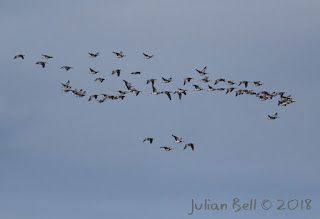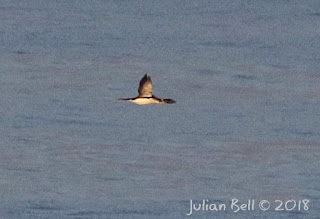Northerly winds and sunny.
It may come as something of a shock but today's trip out went to.....wait for it.....SKOGSØY.
The conditions looked good and it is peak season so it was yet another early start (but still a lot later than the boys from town).
The only new species for the year were a couple of Dunlin myrsnipe heading north together with some Oystercatcher tjeld. They were not yet in breeding plumage.
A total of 10 White-billed Diver gulnebblom passed - mostly at a very nice telescope range.
I managed quite a remarkable photograph today - almost totally lacking in any photographic qualities I managed to capture three species of diver in the same frame - Great Northern, Red-throated and White-billed. Mega.
It was the best day so far this year for a number of species including Red-breasted Merganser siland.
The totals for the six hours of seawatching were as follows:
It may come as something of a shock but today's trip out went to.....wait for it.....SKOGSØY.
The conditions looked good and it is peak season so it was yet another early start (but still a lot later than the boys from town).
The only new species for the year were a couple of Dunlin myrsnipe heading north together with some Oystercatcher tjeld. They were not yet in breeding plumage.
A total of 10 White-billed Diver gulnebblom passed - mostly at a very nice telescope range.
I managed quite a remarkable photograph today - almost totally lacking in any photographic qualities I managed to capture three species of diver in the same frame - Great Northern, Red-throated and White-billed. Mega.
Two Dunlin myrsnipe (top right)
Obligatory Gannet havsule spam
A 2cy Great Northern Diver islom (right) together with three Red-throated Diver smålom
A flock of summer plumaged Long-tailed Duck havelle
It was a good day for Red-breasted Merganser siland migration - at least by the standards of recent years
THIS IS THE PHOTO of the day (if clicked on). Three species of diver in one shot. From right to left:
White-billed Diver, Red-throated Diver, Great Northen Diver, and two more Red-throats.
Some random White-billed Diver gulnebblom shots.
It was the best day so far this year for a number of species including Red-breasted Merganser siland.
The totals for the six hours of seawatching were as follows:
| Red throated Diver N | 239 |
| Great Northern Diver N (2cy) | 2 |
| White Billed Diver N | 10 |
| Northern Gannet N | 27 |
| Northern Gannet S | 1 |
| Great Cormorant N | 37 |
| Great Cormorant S | 4 |
| Eurasian Shag N | 2 |
| Eurasian Shag S | 33 |
| Grey Heron N | 1 |
| Wigeon N | 3 |
| Eider N | 4 |
| Eider S | 1 |
| Long tailed duck N | 33 |
| Long tailed duck S | 3 |
| Common Scoter N | 31 |
| Common Scoter S | 9 |
| Merganser N | 32 |
| Oystercatcher N | 5 |
| Common Gull N | 99 |
| Lesser black backed Gull N | 1 |
| Black-legged Kittiwake N | 1 |
| Common Guillemot N | 13 |
| Common Guillemot S | 1 |
| Razorbill N | 4 |
| Black Guillemot N | 1 |
| Black Guillemot S | 1 |
| Auk N | 19 |
| Auk S | 9 |
The weather forecast tomorrow is such that Skogsøy may not be the best place to be, it is conceivable that I will cover places that have been neglected of late......rest my legs and get another hour or two of badly needed sleep...
























































